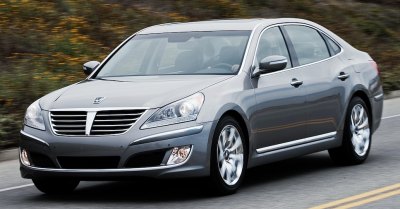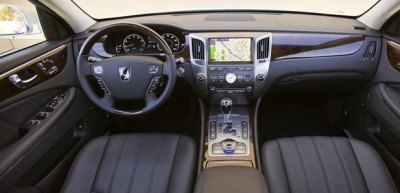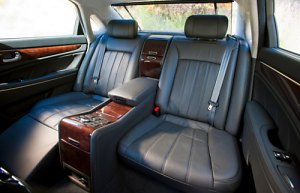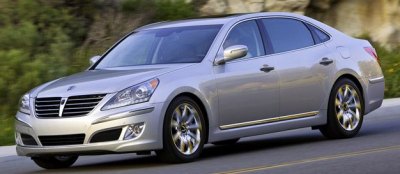Hyundai Equus
Debut: 2009 |
||||||||
Remember the old Equus ? It was an outdated, American-style limousine made largely of Mitsubishi technology. That was more than a decade ago, when Hyundai was still a rising maker of cheap cars. Hardly surprising, the old Equus was by no means world-class. It was only good enough to serve the Korean domestic market, because the patriotic Korean tycoons and enterprises would snap up all its production anyway. In this way, Hyundai sold 120,000 units of Equus in 10 years. Things changed massively. Today, Hyundai becomes the most fearsome competitor to any other mainstream car makers. It is strong at productivity. It masters the latest technology and skill to build world-class vehicles. Its products climb rapidly in social ranking, especially following the introduction of Genesis. The Genesis means a lot to Korean. Its underpinning is their first self-developed rear-drive and V8-powered platform. If properly utilize, it could give birth to a new generation Equus. Considering the cost advantage of Hyundai, it might just repeat the legend of Lexus and give the established European limousines a lot of headache. Well, at least that is what the Korean think. When you encounter the new Equus, you might agree with the above thought. Very elegant it may not be, this car does look carefully designed, and have much the same civilized character of Lexus LS460. If you mask its badge and ask the passer-bys, they might really mistake it for a new Lexus.
Read the spec. sheet, the proud feeling continues. It ticks all the boxes you would expect: a dual-VVT 4.6-liter V8 good for 385hp (just 3hp shy of Mercedes 5.5-liter V8); ZF 6-speed automatic transmission; all-round aluminum multi-link suspensions; electronic-controlled air springs and adaptive damping; wood and leather-wrapped interior; heated, cooled and massaging chairs; airliner reclining rear seat with leg rest; i-Drive-like infotainment control; independent rear seat climate control and entertainment system; refrigerator; Pre-safety system; smart cruise control; lane departure warning; Best of all is the price tag – a fully loaded Equus costs US$60,000 in the United States, some 20 grand cheaper than a similarly equipped Lexus, let alone its European rivals. It seems like a dream come true. However, once you enter the cabin, you will know why it is so cheap. The interior design is dark and conservative to the extent of uninspiring. The analogue gauges are old-fashioned, lacking the sophistication and versatility of the TFT instrument panels found on Mercedes S-class and Jaguar XJ. The wood trim and leather are not too bad, but its rivals offer classier ones. The center console looks as if come from a US$25,000 SUV, especially with its black plastic controls. In fact, we found the center console of Genesis look more satisfying. On the plus side, the Hyundai flagship is just as spacious as its foreign rivals. Boss at the rear seat is well catered for. There are just about any luxury features you can think of, although not implemented in a stylish way.
On the road, the Equus performs less than satisfactory. Yes, it is million miles better than the first generation, but that speaks little. By the standard of Mercedes, BMW and Jaguar, it neither rides nor handles good enough to worry them. First of all, its performance is lackluster. In isolation, the Tau V8 is a good engine, being powerful yet smooth and quiet. The problem is, it is not tuned for torque, unlike its rivals. Coupling to the fact that the Equus does not control its weight as well as its rivals, you get only 333 pound-foot of torque to haul 2080 kilograms, easily the lowest torque-to-weight ratio in the class. As a result, 0-60 mph takes 6.4 seconds, a full second longer than the class norm. Mid-range and in-gear acceleration are equally lackluster, blame to the lack of mid-range torque. Besides, the slightly hesitating ZF 6-speed automatic does not help. This is the poorest ZF 6-speeder we have seen. Perhaps Hyundai did not master the technique of tuning its shift pattern. On the road, running refinement is generally good. The Equus feels big and solid, thanks to extensive use of high-strength steel, sound deadening materials and laminated glass. Wind noise is well insulated from the cabin while powertrain noise is negligible. The only problem is excessive tire noise, which robs it the chance of matching its rivals for acoustic refinement.
Ride and handling depends on the version you drive. Korean domestic version rides on typically soft suspension setup, hence displaying more float and understeer on demanding driving. American version has been retuned to the taste of those used to purchase European limousines. Its ride firmness lies half way between Lexus and BMW. With air suspension fitted (remark: lower spec. models rely on steel springs and mechanical adaptive dampers), the Equus offers a good balance between comfort and body control. However, it is never agile. Road tests found its tire grip, braking performance and cornering agility are all trailing the class standard. Moreover, its electro-hydraulic assisted steering feels artificial and produces unreasonably strong self-centering. If you think the sport button on center console may help sharpening the steering, suspension and transmission, you will be wrong. There is no discernible difference whatever the mode is. Hyundai said it had invested US$380 million in the development of Equus, on the top of another US$600 million spent to develop the Genesis platform and Tau V8. For what it delivers, the Equus is not worth so much. However, see the sum as tuition fee of University Luxury, it might worth spending. Based on the experience learned here, the next generation Equus might just be a world-class luxury car. At the moment, however, it can only sale on a bargain price. |
||||||||
| The above report was last updated on 29 Oct 2010. All Rights Reserved. |
| Specifications | ||||||||||||||||||||||||||||||||||||||||||||||||||||||||||||||||||||||||||||||||||||||||
|
||||||||||||||||||||||||||||||||||||||||||||||||||||||||||||||||||||||||||||||||||||||||
| Performance tested by: *MT |
Copyright©
1997-2010
by Mark Wan @ AutoZine



